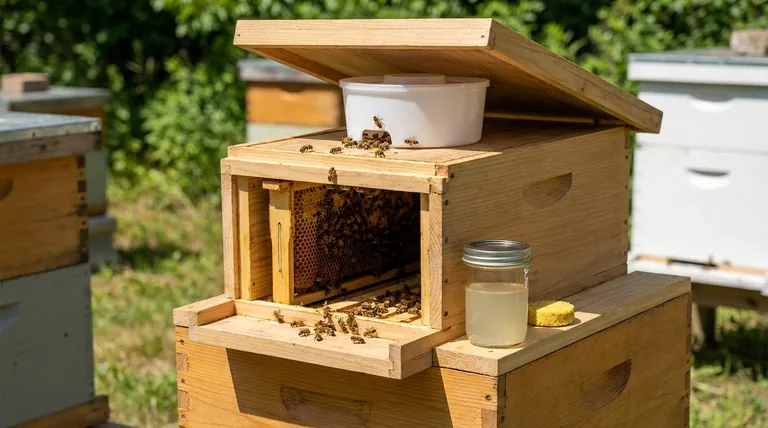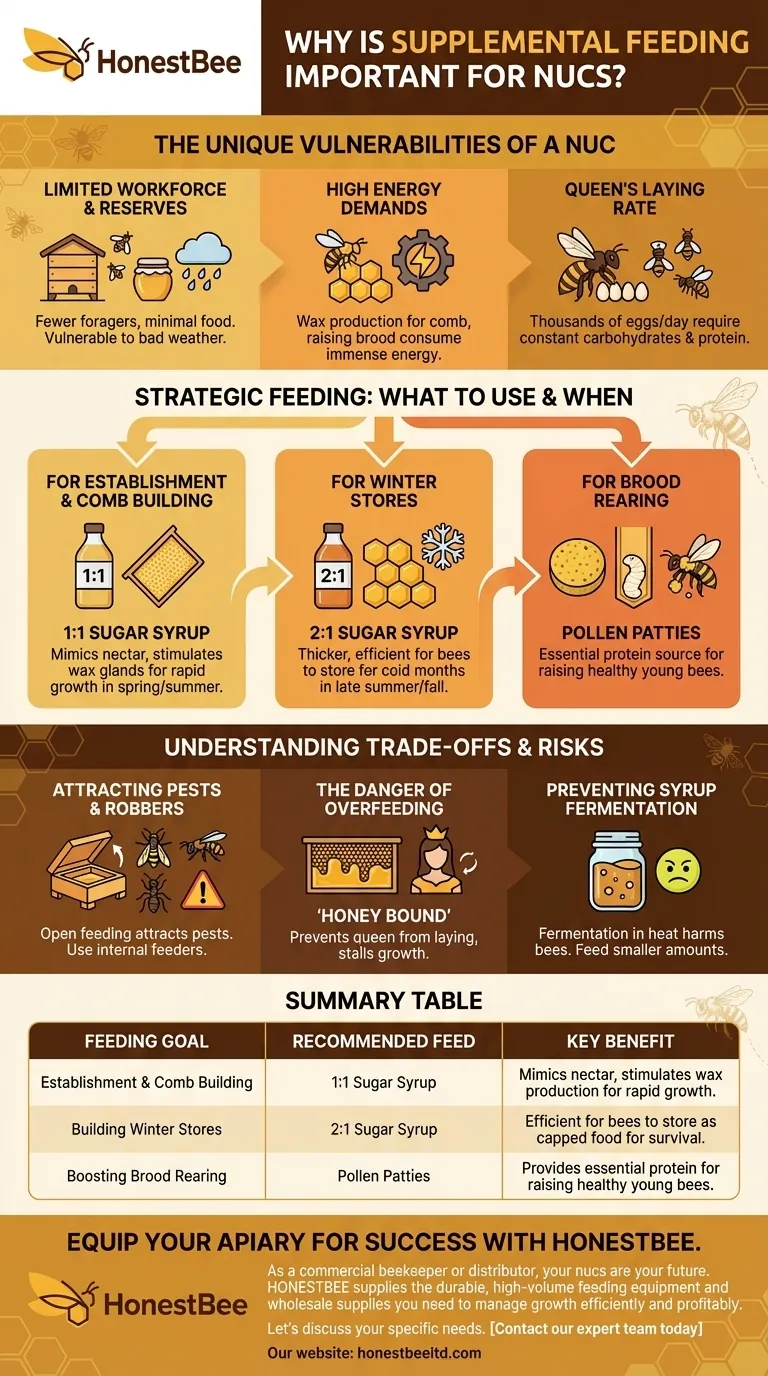Supplemental feeding is a critical management tool for a new nucleus colony (nuc) because its small population and limited resources make it extremely vulnerable to starvation. Unlike a large, established hive, a nuc has fewer foraging bees, minimal food stores, and a high energy demand for building comb and raising brood, causing it to consume its reserves at a rapid pace.
A nucleus colony's primary objective is rapid growth. Supplemental feeding is not merely a safety net against starvation; it is the strategic fuel that powers the population boom required for the nuc to become a strong, self-sufficient hive.

The Unique Vulnerabilities of a Nuc
A nuc is essentially a starter hive, and its small scale presents several inherent challenges that feeding directly addresses. It operates on a razor-thin margin for survival.
Limited Workforce and Reserves
A nuc starts with only a few frames of bees. This small population means there are fewer foragers available to go out and collect nectar and pollen, especially if the weather is poor.
They also begin with minimal stored honey. A cold or rainy week can be enough for the colony to burn through its entire pantry, leading to starvation.
High Energy Demands for Growth
A nuc's two most critical tasks are building new wax comb and raising new bees, both of which are incredibly energy-intensive.
Bees must consume large quantities of sugar (nectar or syrup) to produce wax. Without a steady supply, comb construction grinds to a halt, limiting the queen's space to lay eggs and stalling all future growth.
The Queen's Laying Rate
A healthy queen in a nuc is laying hundreds or thousands of eggs per day to build the population. The nurse bees responsible for feeding this new brood require a constant, rich diet of both carbohydrates (honey/syrup) and protein (pollen). A shortage of either will force the colony to cannibalize its own young.
Strategic Feeding: What to Use and When
Feeding isn't a one-size-fits-all action. The type of feed and the timing depend on your specific goal for the colony.
For Establishment: 1:1 Sugar Syrup
A syrup made with one part sugar to one part water by weight or volume closely mimics natural nectar flow. This is the ideal feed for a newly installed nuc in the spring or summer.
This ratio stimulates the bees' wax glands, encouraging them to rapidly draw out new foundation into comb. This is the top priority for a new colony.
For Winter Stores: 2:1 Sugar Syrup
In the late summer or fall, the goal shifts from building comb to storing food for winter. A thicker syrup of two parts sugar to one part water is more efficient for this purpose.
The bees don't have to work as hard to dehydrate this thick syrup and cap it as winter "honey." It helps them quickly gain the weight needed to survive the cold months.
For Brood Rearing: Pollen Patties
Carbohydrates from syrup provide energy, but bees need protein to raise their young. Pollen is their natural protein source.
If you see the queen laying but the population isn't growing, or if there is very little natural pollen coming in, a pollen patty provides the protein necessary to support a healthy brood cycle.
Understanding the Trade-offs and Risks
While necessary, supplemental feeding must be done correctly to avoid creating new problems for your vulnerable nuc.
Attracting Pests and Robbers
Open-feeding or spilling syrup near the hive can attract ants, yellow jackets, and robber bees from stronger nearby hives. A robbing attack can overwhelm and destroy a small nuc in a matter of hours.
Always use an internal feeder (like a frame feeder or top feeder) to keep the food source contained within the hive and reduce the entrance to make it more defensible for the small population.
The Danger of Overfeeding
It is possible to give a nuc too much syrup. If the bees run out of space, they will begin storing the syrup in the brood nest cells.
This is called being "honey bound" and leaves the queen with no room to lay eggs, effectively stopping colony growth. Monitor the brood area and reduce feeding if you see syrup being stored where eggs should be.
Preventing Syrup Fermentation
In warm weather, sugar syrup can ferment quickly, which can be harmful to bees. Only provide an amount of syrup that the bees can consume within a few days, and be sure to clean your feeders regularly.
Making the Right Choice for Your Colony
Your feeding strategy should directly support your colony's immediate needs.
- If you just installed a new nuc in spring: Feed a 1:1 sugar syrup continuously until they have drawn out all the frames in their first hive box.
- If your colony is struggling to grow its population: Supplement with a pollen patty to provide the protein needed to raise more brood.
- If your hive feels light in late summer or early fall: Begin feeding a 2:1 sugar syrup to help them build sufficient winter stores before cold weather sets in.
Proper feeding transforms a vulnerable nucleus colony from a liability into a thriving, productive hive.
Summary Table:
| Feeding Goal | Recommended Feed | Key Benefit |
|---|---|---|
| Establishment & Comb Building | 1:1 Sugar Syrup | Mimics nectar, stimulates wax production for rapid growth. |
| Building Winter Stores | 2:1 Sugar Syrup | Efficient for bees to store as capped food for survival. |
| Boosting Brood Rearing | Pollen Patties | Provides essential protein for raising healthy young bees. |
Equip your apiary for success with HONESTBEE.
As a commercial beekeeper or distributor, your nucs are your future. Proper supplemental feeding is non-negotiable for turning vulnerable starter colonies into productive assets. HONESTBEE supplies the durable, high-volume feeding equipment and wholesale supplies you need to manage growth efficiently and profitably.
Let's discuss your specific needs. Contact our expert team today to get the right solutions for your operation.
Visual Guide

Related Products
- Rapid Bee Feeder White Plastic 2L Round Top Feeder for 8 or 10-Frame Bee Hives
- HONESTBEE Entrance Bee Feeder Professional Hive Nutrition Solution for Beekeeping
- HONESTBEE Professional Entrance Bee Feeder Hive Nutrition Solution
- HONESTBEE Round Hive Top Bee Feeder for Syrup
- In-Hive Dual Compartment Frame Bee Feeder for Targeted Colony Nutrition
People Also Ask
- Can you dilute honey and feed it to the bees? Understand the Critical Risks and Safe Practices
- Do beekeepers leave honey for bees? The Essential Guide to Sustainable Hive Management
- What is the capacity of the round hive top feeder for syrup and pollen? A Guide to Targeted Apiary Support
- What is the advice regarding feeding bees to limit brood production based on? Managing Prolific Bee Strains
- Can sugar syrup contaminate the honey crop? A Beekeeper's Guide to Protecting Honey Purity



















